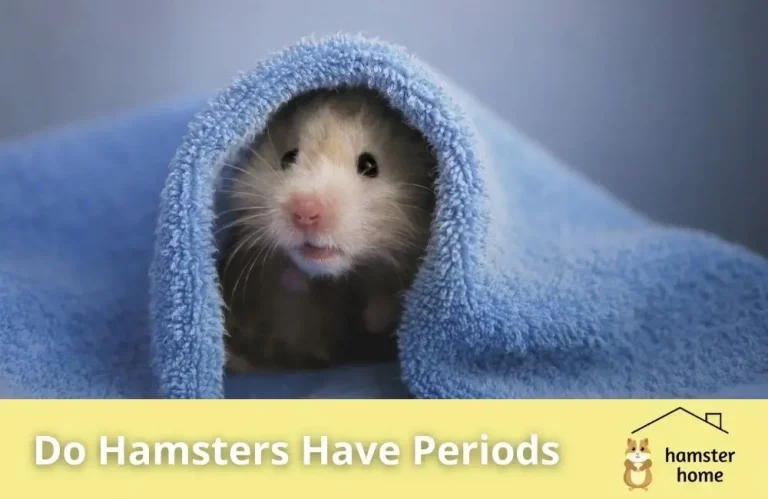Are you worried about any unusual excretions coming out of your female hamster’s private part? Well, it could simply be its estrus cycle, or it could also indicate some serious health issues.
Hamsters are probably the least expressive pets. It makes it even harder for pet owners to ensure their well-being. One should constantly keep checking their behavior or physical signs of illness.
Carelessness in the case of hamsters can be fatal for them. Hence read this post till the next to keep your hamster safe and healthy.
Let’s Dive In:
What Is Estrus Cycle?
Where women have menstrual cycles, female hamsters have something similar called estrus cycles. Estrus cycle is also considered a synonym of the “in heat” condition of a female hamster.
Everything in the world of hamsters is small and fast. Unlike women’s periods, which occur once a month, the estrus cycle occurs after every 4 days in hamsters. Isn’t that astonishing? This cycle usually happens during the time your hamster is most active, and that is the nighttime.
Needless to say that only female hamsters have this estrus cycle. Unlike periods that occur in women in the form of vaginal bleeding, hamster’s discharge is in the form of whitish mucus instead of blood. It is also usual to see a drop of blood with this discharge but only a drop.
Facts Related to Estrus
There are some valuable facts that you should be aware of as a hamster owner. Following are some common facts related to the estrus cycle:
Sexual Maturity & Estrus Cycle
The Estrus cycle is basically the reproductive cycle of your hamster. It’s basic science that every animal has a reproductive system that is responsible for its reproduction. When your beloved hamster(female) reaches the age of 6-7 weeks, it becomes sexually mature.
Female hamsters start getting heated after some time of reaching sexual maturity. This time depends upon the breed of the hamsters.
For some breeds, this time is affected by external factors like the presence of males around them. In others, the time when they start getting heated is independent of any external factor.
Duration
As mentioned earlier, this estrus cycle occurs every one out of four days. Nocturnal is a term used for animals that are relatively more active at night than in the day. Our beloved hamster, as you might already know, belongs to this group.
Being a nocturnal animal, the estrus cycle of the hamsters mainly occurs at night time. Upon noticing, you will get to know that these cycles don’t usually last more than 12 hours.
Base of Breeding
Reproduction or breeding of a hamster depends upon this estrus cycle. A female hamster is likely to get pregnant when she mates during the estrus cycle. Even if the hamster has become sexually mature, it can’t reproduce until its estrus cycle has started.
Having a healthy and frequent estrus cycle is very important for the health of the hamster. The estrus cycle stops when the female gets pregnant or old, just like periods in women. Hence, it is safe to say that the estrus cycle is an essential element of reproduction in hamsters.
Behaviour With Male Hamsters
You might have noticed that female hamsters often repel male hamsters under natural circumstances. You will be amazed to see the difference between the behaviors of female hamsters towards male hamsters during this cycle.
During an estrus cycle, female hamsters tend to be welcoming towards male hamsters for mating purposes.
Pregnancy & Excretions
There could be several kinds of discharges from the private part of your hamster during pregnancy. Most first-time hamster owners confuse these discharges with periods which is not valid.
Following are the unusual substances that you will likely witness during and after the process of mating:
Right After Mating
The night after mating, you will witness a semi-solid creamy substance on the private part of your hamster. It will only show up if the male hamster successfully mates with the female hamster.
This copulatory plug is basically an indication itself of successful mating.
The next part could be a little scary for first-time hamster owners if they don’t have much knowledge regarding the mating process of the hamsters. After the night of mating, it is typical for the female hamster to discharge a whitish, thick substance.
During Pregnancy
Mommy-to-be will start showing signs of pregnancy after 10-18 days of mating. Depending upon the species of your hamster, a female hamster will give birth to six to eight litters after 16-22 days. While your hamster is pregnant, you should also be prepared to welcome the pups.
The only expected secretion you will witness is a bloody discharge before the birth of the litters.
These are the things you should be prepared for if you are planning to mate your hamster. If you notice any secretions or discharges beyond these, you should immediately contact your vet.
This will help you in timely addressing the complications that may arise during the pregnancy of your hamster.
Is Reproductive Cycle Of Hamsters Different From Other Pets?
Have you ever kept a pet dog or a cat before buying a hamster? After all this information, wondering “is there any difference between their reproductive cycles and hamsters? Well, we will cover each and every aspect in this thread to answer all your questions.
Fundamentally, the reproductive cycles of hamsters and other pets like cats and dogs are similar. They both require a healthy estrus cycle in order to reproduce. The difference between their reproductive cycles lies in the frequency of the cycles.
In simple words, a cat or a dog will get on the heat around 2-3 times a year. On the flip side, a female hamster is on heat every one out of 4 days.
Moreover, the duration of reproductive cycles of cats and dogs is much longer than hamster’s estrus cycles. The estrus cycle of a cat or a dog could last for a week or two. Contrarily the estrus cycle of a hamster is only around 12 hours long.
These are the significant differences between the reproductive cycles of hamsters and other common pets.
Signs of A Healthy Estrus Cycle
For your convenience, we have done all the research that is necessary for keeping your hamster healthy. Here are the signs of a healthy estrus cycle of a hamster:
Smell
A solid musky smell is one of the most prominent signs of a healthy estrus cycle. It will help you keep track of your hamster’s estrus cycles, which is vital for its health. When your hamster is in heat, it is better to place its cage in the open air.
It is advised because this odor is long-lasting, and its effects are unpleasant. Another practice you should follow is washing hands immediately after holding your hamster.
Minute Swelling
If you notice minute swelling or redness on the private area of your hamster during the estrus cycle, then don’t worry because it’s quite common. It occurs due to unusual excretion.
Discharge
The discharge of semi-thick mucus from the virginal tract of your hamster is a clear indication of the reproductive cycle. This excretion can also help you in checking the condition and working of your hamster’s internal organs.
For this purpose, you have to notice the color and texture of excretion. If the color of the excretion is yellowish instead of whitish, this is an indication of Pyometra. Pyometra is a medical condition found in hamsters that we will discuss later in this article.
Behaviour
Change in the behaviour towards opposite gender hamsters is also an indication of a healthy estrus cycle. When everything inside the body of a hamster is working fine, it will be open to mating.
If the female hamster doesn’t let male hamsters get close during the estrus cycle, then there’s something wrong. If the hamster doesn’t show any abnormal behaviour abnormalities, this could be an indication of illness or injury.
The best way to figure it out is by talking to your vet.
Related Health Conditions
There are some conditions that are exclusive to the reproductive organs. As a hamster’s owner, you must be aware of these conditions to adequately take care of your hamster’s health.
Following are the most common health conditions related to hamsters reproductive systems:
Bleeding
You have to understand that hamsters’ reproductive systems don’t work like the human reproductive systems.
Among significant differences is that the human’s menstrual cycle involves a bloody discharge and the hamster’s estrus cycle doesn’t. So if you see your hamster bleeding, then it is not a good sign.
There could be multiple reasons behind this bleeding, and none of them is good. This internal bleeding could be because of:
Illness
If excessive blood is coming through the private part of your furball, then the chances are that she is ill. The bad news is that the situation is serious. The only thing you should do in such a situation is rush to the vet.
There could be multiple diseases related to hamsters that can cause internal bleeding.
Internal Injury
Sometimes, hamsters fall in their cage and hit the edges, which can cause injuries. In most cases, these injuries are visible, but sometimes the skin is fine, but an internal organ is damaged.
Excessive internal bleeding can be fatal; hence it is crucial for you to consult your vet urgently.
Antibiotics
Another reason that you couldn’t have been thought about is the medicine itself given to heal the hamsters. High-potency antibiotics can cause internal bleeding inside the bodies of the hamsters.
It is because the internal tissues of the hamster’s body are very delicate. If you give an antibiotic to your hamster and witness bloodstains in the cage, immediately halt the course.
Consult with your vet on an urgent basis so he can change the medicine if required.
Pyometra
If your hamster hasn’t mated for 15-20 days and her belly is swollen, then this could be a Pyometra’s sign. Now, what is pyometra? Urinary tract infection in hamsters is termed pyometra.
Common symptoms of this disease are:
- Swollen Belly
- Inactiveness
- Yellow, foul-smelling discharge
- The sluggish behaviour of the hamster
If left untreated, this disease can take the life of your precious pet in a week. It is why you should never ignore such symptoms and contact your vet without wasting time.
Wet Tail
Wet Tail is another medical condition that is often confused with hamster periods. In actuality, a wet tail is an indication of diarrhoea. Just like other pets, our cute little hamsters are also prone to diarrhoea.
This disease is more common in Syrian hamsters than in any other breed. Typically, hamsters older than 12 weeks are relatively safer than the younger ones. It is because their immune systems have developed, and they don’t get that easily scared.
There could be multiple situations that can become the cause of diarrhoea in hamsters. Stress in these little creatures causes diarrhoea more than anything.
Hamsters are faint-hearted animals, and events like a sudden change in environment, attack by another hamster or any other animal, too much noise around for longer durations can cause this stress.
Wet Tail is, in fact, the most prominent feature of diarrhoea. Upon noticing the wet Tail of your hamster, start observing their behaviour. If the Tail doesn’t get dried soon after, it’s time to pay a visit to the vet.
In such instances, you can’t afford carelessness because prolonged diarrhoea can lead to the death of your hamster.
Precautionary Measures You Should Take
Seasoned hamsters owners have shared some tips that have helped them to prevent illness in their hamsters. For your convenience, we have gathered the most important of these points in one place.
By following the points discussed below, you will be able to keep your hamster fit and healthy:
Clean Cage Regularly
The best thing you can do for your hamster’s health is to clean its cage regularly. Most of the diseases, either reproductive or general, are caused to the bacteria’s development in the hamster’s cage.
When the cage of your hamster is left uncleaned for long durations, bacteria starts developing in it. This bacteria feeds upon the decaying food left in your hamster’s cage. Another favourite habitat of bacteria is the excretions of your hamster.
On that account, you must maintain the hygiene of your hamster’s cage at any cost.
Avoid Giving Fresh Food
We love our beloved pets and want to do as much as we can for them. It is why we are tempted to share fresh veggies and fruits with our hamsters.
There’s nothing wrong with giving fresh fruits or veggies to hamsters, but the thing is that they are hard-wired to hide their eatables for consuming later, and this practice becomes very dangerous when fresh veggies and fruits are involved.
When fruits are stored for long durations, they start decaying and become harmful to consume.
Hence, no matter how tempted you are, avoid sharing fruits and fresh veggies with your hamster next time.
Visit Vet Frequently
One visit a month to the vet’s clinic keeps illness away. This is what seasoned hamster owners emphasize more than anything. We know taking out time from your hectic routine is pretty daunting but believe us, it’s worth it.
Conclusion
It won’t be suitable to call the estrus cycle of the hamsters period because it is associated with women’s menstrual cycle. Moreover, estrus cycle discharge is entirely different from menstrual cycle bloody discharge.
As a female hamster owner, you should be completely aware of your hamster’s estrus cycle’s fundamentals. It is necessary to take care of your little furry friend adequately.
In this thread, we tried our best to cover all the aspects of the hamster’s estrus cycle for you. By following the tips shared in this thread, you can prolong the lifespan of your hamster.
FAQs
First-time hamster owners get confused pretty easily. Considering this fact, we have tried answering some common questions:
We have seen new hamster owners getting terrified to see estrus cycle discharge for the first time. There is nothing to worry about here. The Estrus cycle is a natural process and necessary for the reproduction of your hamster.
In point of fact, delay or abnormality in the estrus cycle is something that should scare you.
Although some species get sexually mature at the age of 5 weeks but that’s rare. The first heat cycles of most of these tiny creatures start between 6-10 weeks of age.
A drop of blood is expected but not more than that. If there is blood equal to a drop and semi-thick whitish substance in estrus cycle discharge, there’s nothing to worry about. If you find excessive bleeding, then start your car and take your hamster to the vet immediately.







